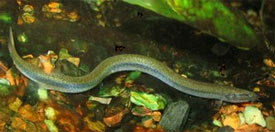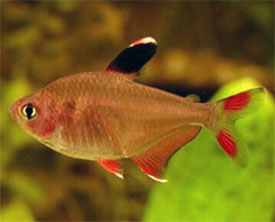
 Magyarul / Hungarian
Magyarul / Hungarian



- Scientific name: Metynnis hypsauchen
- Synonyms: Myletes hypsauchen (Müller & Troschel, 1844), Metynnis calichromus schreitmuelleri (Ahl, 1922), Metynnis schreitmuelleri (Ahl, 1922), Metynnis calichromus (Ahl, 1923), Metynnis ehrhardti (Ahl, 1927)
- Common name: Silver Dollar
- Group: Characins
- Distribution: South America; Guyana, Brazil, Peru, Bolivia; in the Amazon and Rio Paraguay drainages
- Size: 14-15 cm
- Biotope: Inhabits the densely planted shallow waters.
- Social behavior: A generally peaceful fish, that can be kept with other larger peaceful species, but it will eat smaller fishes. They mainly occupy the middle and top watercolumn, so bottom dweller fishes can be a wise choice as tankmates.
- Diet: Omnivorous; it will eat all kinds of live, frozen and dried foods, but its main diet must be vegetable matter, or the fish will eat all aquatic plants. Give the fish lettuce, spinach, cucumber, courgette and other green vegetables.
- Breeding: Quite hard
- Tank: Minimum 250 litres
- Population: 5-6 fish for 350 litres
- Decoration: They need a large aquarium with dark soil, some larger rocks and some tree branches. Live plants can be placed in the tank, but they will eat even the hardy plants such as Anubias. Soft-leaved plants will be eaten, their favourite is the duckweed. Artificial plants could be used.
- Temperature: 24-28 °C
- pH: 6.0-7.0
- Hardness: 2.0-10.0 dGH
- Lifespan: 5-8 years
Anal fin is more elongated and the red coloration is more intense on the male.
Silver dollars are group spawners, so a large breeding tank (at least 150 litres) is needed to provide enough space for the fish. Fill the tank with soft (8-10 dGH), slightly acidic water with a temperature of 28 °C. Place a few clumps of fine-leaved plants such as java moss to the bottom of the aquarium, or place some kind of mesh with a large enough grade so the eggs can fall through it and can protect the eggs from the adults. Carrying out a water change with slightly warmer water may help trigger spawning. At first the fish may be a little shy, but a few days later the fish should begin to spawn, usually in the morning time. Males assume a dark coloration around the anal, caudal and dorsal fins when ready to spawn, and the reddish coloration around the chest areas will also intensify. Males will pursue the females hard during the courtship, and when a female is ready to breed, eggs will be released, which are then fertilised by the male. The eggs are 2-2.5 mm in diameter which are sink to the bottom of the aquarium. Silver dollars are not as likely to eat their own eggs as some other characins, but should still be removed when spawning is complete. The number of the eggs can be 2000. The eggs hatch after 3 days, and the larvae become free-swimming after another 3-4 days at 26-28 °C. The fry are eagerly eating the small live foods and will grow very quickly.
https://www.fishbase.de/summary/Metynnis-hypsauchen
https://www.seriouslyfish.com/species/metynnis-hypsauchen
http://badmanstropicalfish.com/profiles/profile23.html



































































